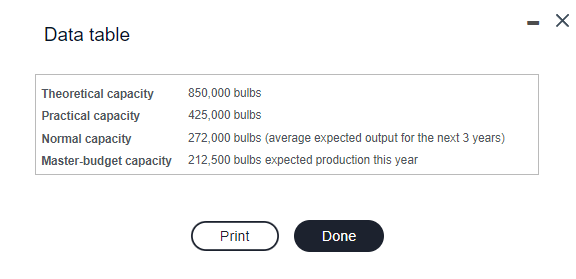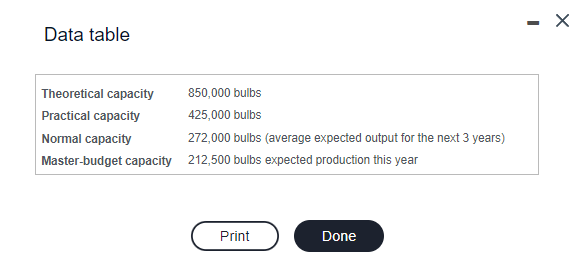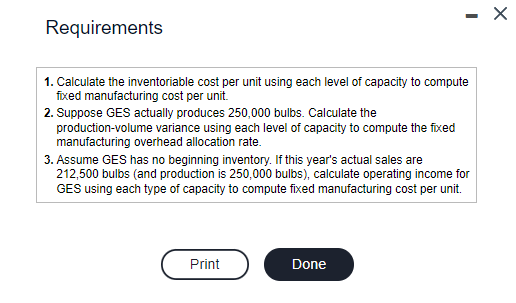Question
It is the end of 2020. Tessa AllFixed Corporation began operations in January 2019. The company is so named because it has no variable costs.



It is the end of
2020.
Tessa AllFixed
Corporation began operations in January
2019.
The company is so named because it has no variable costs. All its costs are fixed; they do not vary with output.
Tessa AllFixed
Corp. is located on the bank of a river and has its own hydroelectric plant to supply power, light, and heat. The company manufactures a synthetic fertilizer from air and river water and sells its product at a price that is not expected to change. It has a small staff of employees, all paid fixed annual salaries. The output of the plant can be increased or decreased by pressing a few buttons on a keyboard. The following budgeted and actual data are for the operations of
Tessa AllFixed.
LOADING...
(Click the icon to view the budgeted and actual data.)Read the requirements
LOADING...
.
Question content area bottom
Part 1
Requirement 1. Prepare income statements with one column for
2019,
one column for
2020,
and one column for the 2 years together using (a) variable costing and (b) absorption costing. (Use parentheses or a minus sign for an operating loss.)Start by preparing the (a) variable costing income statement for
2019,
2020,
and the 2 year total.
|
| 2019 |
| Revenue |
|
| Fixed costs: | |
| Manufacturing costs |
|
| Operating costs |
|
| Total fixed costs |
|
| Operating income (loss) |
|
| 2020 |
|
|
|
|
|
|
|
|
|
|
|
|
| Total |
|
|
|
|
|
|
|
|
|
|
|
|
Part 2
Now prepare the (b) absorption costing income statement for
2019,
2020,
and the 2 year total. (Enter a "0" for any $0 balances. Use parentheses or a minus sign for an operating loss. Label each variance as favorable (F) or unfavorable (U). Use units of production as the denominator level in the allocation rate.)
|
| 2019 |
| Revenue |
|
| Cost of goods sold | |
| Beginning inventory |
|
| Allocated fixed manufacturing costs |
|
| Deduct ending inventory |
|
| Adjustment for production-volume variance |
|
| Total cost of goods sold |
|
| Gross margin |
|
| Operating costs |
|
| Operating income (loss) |
|
| 2020 | |
|
| |
|
| |
|
| |
|
| |
|
| |
|
|
|
|
| |
|
| |
|
| |
|
|
| Total | |
|
| |
|
| |
|
| |
|
| |
|
| |
|
|
|
|
| |
|
| |
|
| |
|
|
Part 3
Requirement 2. What is the breakeven point under (a) variable costing and (b) absorption costing?
Start by calculating the breakeven point under (a) variable costing. (Round your answer up to the nearest unit.)
|
|
|
|
| Breakeven point |
|
|
| = | under variable costing | |
|
|
| = |
|
Part 4
Now calculate the breakeven point under (b) absorption costing. Enter the formula labels and amounts needed to calculate the absorption costing breakeven sales. (Assume "P" is the production level in units. Abbreviations used: MOH = manufacturing overhead, CM = contribution margin.)
|
| + [ |
| ( |
| - |
| ) ] = | Revenue |
|
| + [ |
| ( |
| - | P | ) ] = |
|
Part 5
(Round your answer up to the nearest unit.)
| The breakeven point under absorption costing when sales are |
| tons is |
| units. |
Part 6
Requirement 3. What inventory costs would be carried in the balance sheet on December 31,
2019
and
2020,
under each method? (For accounts with a $0 balance, enter a $0 in the appropriate cell.)
|
| December 31, 2019 | December 31, 2020 |
| Variable costing |
|
|
| Absorption costing (nonmanufacturing) |
|
|
Part 7
Requirement 4. Assume that the performance of the top manager of the company is evaluated and rewarded largely on the basis of reported operating income. Which costing method would the manager prefer? Why?
Operating income is affected by both production and sales under
absorption costing.
variable costing.
Most managers would prefer
absorption
variable
costing because their performance in any given reporting period, at least in the short run, is influenced by
how much production is scheduled near the end of a period.
the fixed manufacturing costs required to produce the breakeven units.
the total year end inventory.
Data table Data table Requirements 1. Calculate the inventoriable cost per unit using each level of capacity to compute fixed manufacturing cost per unit. 2. Suppose GES actually produces 250,000 bulbs. Calculate the production-volume variance using each level of capacity to compute the fixed manufacturing overhead allocation rate. 3. Assume GES has no beginning inventory. If this year's actual sales are 212,500 bulbs (and production is 250,000 bulbs), calculate operating income for GES using each type of capacity to compute fixed manufacturing cost per unit. Data table Data table Requirements 1. Calculate the inventoriable cost per unit using each level of capacity to compute fixed manufacturing cost per unit. 2. Suppose GES actually produces 250,000 bulbs. Calculate the production-volume variance using each level of capacity to compute the fixed manufacturing overhead allocation rate. 3. Assume GES has no beginning inventory. If this year's actual sales are 212,500 bulbs (and production is 250,000 bulbs), calculate operating income for GES using each type of capacity to compute fixed manufacturing cost per unitStep by Step Solution
There are 3 Steps involved in it
Step: 1

Get Instant Access to Expert-Tailored Solutions
See step-by-step solutions with expert insights and AI powered tools for academic success
Step: 2

Step: 3

Ace Your Homework with AI
Get the answers you need in no time with our AI-driven, step-by-step assistance
Get Started


